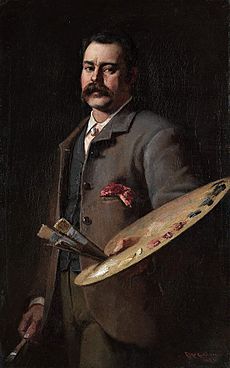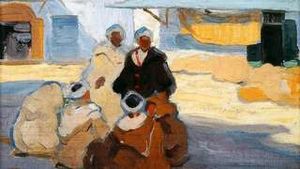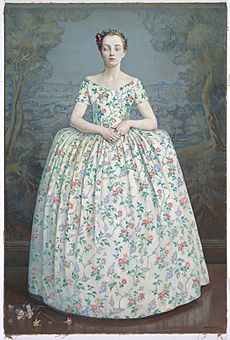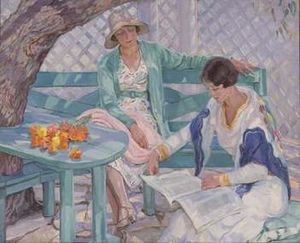Hilda Rix Nicholas facts for kids
Quick facts for kids
Hilda Rix Nicholas
|
|
|---|---|

Rix Nicholas, c. 1920, dressed as "the spirit of the bush"
|
|
| Born |
Emily Hilda Rix
1 September 1884 |
| Died | 3 August 1961 (aged 76) Delegate, New South Wales, Australia
|
| Nationality | Australian |
| Education |
|
| Known for | Painting, drawing |
|
Notable work
|
|
Hilda Rix Nicholas (née Rix, later Wright, born September 1, 1884 – died August 3, 1961) was an important Australian artist. She was born in Ballarat, Victoria. Hilda studied art at the National Gallery of Victoria Art School from 1902 to 1905. Her teacher was Frederick McCubbin, a famous Australian Impressionist painter.
After her father died in 1907, Hilda, her sister Elsie, and her mother traveled to Europe. There, she continued her art studies in London and Paris. She learned from teachers like John Hassall and Richard Emil Miller.
In 1912, Hilda visited Tangier in Morocco. Her art from this trip became very successful. The French government even bought one of her drawings, Grande marché, Tanger. She was one of the first Australian artists to paint in a Post-Impressionist style. Her paintings were shown in the famous Paris Salon in 1911 and 1913.
World War I brought great sadness to Hilda's life. Her sister died in 1914, and her mother died in 1915. In 1916, she married George Matson Nicholas, but he was killed in the war just one month later.
Hilda returned to Australia in 1918 and started painting again. She held a big exhibition in Melbourne, and many of her works sold. Later, she went back to Europe. In 1925, a Paris exhibition led to her painting In Australia being bought by the Musée du Luxembourg. Her art was then shown in many galleries across Britain.
In 1926, Hilda came back to Australia for good. She married Edgar Wright in 1928, and they settled on a farm near Delegate, New South Wales. Their son, Rix Wright, was born in 1930. Hilda continued to paint, creating works like The Summer House and The Fair Musterer. However, her traditional style became less popular as new art movements like modernism emerged. She had her last solo art show in 1947. Hilda Rix Nicholas lived in Delegate until she died in 1961. Her paintings are now in major Australian art collections.
Contents
Early Life and Art Training
Hilda Rix Nicholas was born on September 1, 1884, in Ballarat, Victoria. Her parents, Henry Finch Rix and Elizabeth Sutton, had moved to Australia as children. Hilda had an older sister named Elsie Bertha.
Their family was very talented. Her father, Henry, was a math teacher and a poet. He also played Australian rules football. Her mother, Elizabeth, was a singer and helped run her parents' music business. She also painted still lifes and landscapes.
Hilda and Elsie both played music and performed. Hilda loved drawing from a young age. She was praised for her art while at Melbourne Girls Grammar high school. Hilda then studied at the National Gallery of Victoria Art School from 1902 to 1905. Her teacher was Frederick McCubbin, a leading Australian Impressionist.
Hilda's drawings were shown in art exhibitions even when she was a student. She also worked as an illustrator for textbooks. In 1903, Hilda, Elsie, and their mother all had art in an exhibition together.
It was common for Australian artists to study in Europe. Hilda's father planned a trip for the family in 1906. Sadly, he died suddenly. The family faced financial challenges but managed to travel to England in 1907. They used an inheritance and money from selling art.
Studying Art in Europe
Before leaving Australia, artist Arthur Streeton advised Hilda to learn from many different teachers. This way, she could keep her own unique style. Hilda followed this advice throughout her career.
One of her first teachers in Europe was John Hassall. Hilda admired his simple and direct style. In late 1907, Hilda, Elsie, and their mother moved to Paris. Hilda studied at the Académie Delécluse, where she learned a lot about drawing people. She also studied with American Impressionist Richard Emil Miller, who taught her to use bright colors. Later, she learned from Théophile Steinlen at the Académie de la Grande Chaumière.
Hilda and her family spent summers traveling. In 1908, they explored France and Italy. They also visited the Etaples art colony in northern France, where many artists worked.
Hilda's hard work paid off. Her paintings were shown at the Paris Salon in 1911. She became only the second Australian artist to have her work bought by the French government. This showed she was becoming a very successful artist in France.
Painting in Morocco
Many women artists visited North Africa in the early 1900s. Hilda traveled to Morocco twice, and these trips greatly influenced her art. She first went to Tangier in January 1912 with American painter Henry Ossawa Tanner.
For about three months, Hilda sketched and painted in Tangier. She loved the open-air market, called a soko. She wrote about how much she enjoyed it and how the sun inspired her.
Hilda's Moroccan paintings used bright colors to capture the strong North African light. She focused on the people, their clothes, and their daily activities. Her style became more "post-impressionistic" during this time. This means her paintings used loose brush strokes and focused on light and shadow.
Hilda was one of the first Australians to paint Post-Impressionist landscapes. Her paintings like Men in the Market Place, Tangier (1914) show her developing style.
The 1912 trip was a turning point for her art. It led to several exhibitions and international praise. The French government bought her pastel drawing, Grande marché, Tanger. Australian newspapers reported her success. She was invited to exhibit at the Société des Peintres Orientalistes Français in Paris and became a member.
She returned to Tangier in early 1914 with her sister Elsie. Hilda often painted at the soko, attracting a lot of attention. The sisters returned to France, but the start of World War I forced them to evacuate to London in August.
A Time of Sadness
Hilda's return to London marked a very difficult period. Her mother, Elizabeth, became very ill. Then, her sister Elsie fell ill with typhoid and died on September 2, 1914. Hilda kept this news from her mother for three months. Elizabeth died in March 1916. Hilda was just over thirty, and all her close family members were gone. She later wrote that she felt like an "old thing."
More sadness followed. In September 1916, Hilda met Captain George Matson Nicholas, an Australian officer. They married on October 7 in London. But just five weeks later, on November 14, he was killed in battle in France.
Hilda was heartbroken. Her grief inspired three paintings: And Those Who Would Have Been Their Sons, They Gave Their Immortality, Desolation, and Pro Humanitate. Desolation showed a sad woman in a black cloak on a battlefield. It was a powerful image of loss. The charcoal drawing for Desolation is now at the National Gallery of Australia. Pro Humanitate showed the tragedy of her short marriage. These paintings were very personal and showed the deep impact of the war on her.
Back to Australia
In March 1918, Hilda Rix Nicholas returned to Melbourne, Australia. With encouragement from other artists, she began to rebuild her art career. In November, she had a large exhibition of over a hundred of her European and North African paintings. Many works sold, including In Picardy, which was bought by the National Gallery of Victoria. Critics praised her "fearless handling of sunlight." When the exhibition moved to Sydney in 1919, it was also very successful. The Art Gallery of New South Wales bought several of her paintings.
In 1919, Hilda moved to Sydney. She continued to paint landscapes and outdoor portraits. Her exhibitions were well-received. However, the art world in Australia was changing. There was a lot of debate about modernism. Hilda's style became more traditional, which eventually affected her career.
In 1922, Hilda entered a competition for a mural to remember World War I. She was very upset when another artist was chosen, even though he hadn't followed the rules. Some people believed her gender played a role in the decision.
The Australian War Memorial also rejected her triptych Pro Humanitate, saying it was "too intimate." They bought a painting of a French woman instead of her painting of an Australian soldier. This showed how institutions at the time had specific ideas about what women artists should paint. However, her works were popular with soldiers themselves.
Hilda became very interested in showing the beauty of Australia in her art. She wanted to show Europeans "what is possessed in a land of beauty." She traveled to rural New South Wales, including Delegate. Here, she created works like In Australia and The Shearers. She often painted women in her portraits, showing them in rural life.
In August 1923, Hilda had another successful exhibition in Sydney. Critics often described her work as "virile" or strong, which she took as a compliment, as women artists were often dismissed.
Second Trip to Europe
In 1924, Hilda Rix Nicholas traveled to France again, planning to show her art in Europe. She sailed on a ship with the Australian Olympic team and even painted a portrait of one of the athletes.
In Paris, she rented a studio that once belonged to famous French artist Rosa Bonheur. An exhibition in January 1925 was a big success. Her painting In Australia was bought by the Musée du Luxembourg. This made her the only Australian woman to have more than one work in their collection. Her paintings then toured many galleries across Britain, which was a major achievement for an Australian artist.
In Australia shows Ned Wright, a farm manager, on horseback. He looks confident and heroic, with an Australian landscape behind him. This painting captured the strong national pride in Australia at the time.
Hilda had more exhibitions in 1925, including in London. Her painting His Land was praised for showing "the spirit of life in the Commonwealth." This work, like In Australia, showed the strength and energy Hilda believed Australian painting should have.
In 1925, Hilda created one of her largest and most unusual works, Les fleurs dédaignées ('The despised flowers'). This tall painting shows a young woman in old-fashioned clothes. It was painted in a unique style and showed Hilda's skill and ambition. When it was shown in Sydney in 1927, critics were very impressed by its drama and clear technique.
In 1926, Hilda's painting Le Bigouden was shown at the Royal Academy of Art in London. She also had eight works in the Société Nationale des Beaux-Arts Spring exhibition in Paris, which was a very large number for one artist. She was even elected an Associate of the organization.
At the end of 1926, Hilda returned to Australia. She bought a car and traveled around, painting landscapes from Canberra to Queensland. She even painted people on the beach at Bondi.
Life at Knockalong
Hilda had met the Wright family, farmers, in the early 1920s. On June 2, 1928, she married Edgar Wright. They settled on a farm called Knockalong, near Delegate. She continued to use her artistic name, Rix Nicholas. In 1930, their only child, a son named Rix, was born.
Hilda continued to paint, often focusing on portraits. She frequently painted women enjoying rural life, like in The Fair Musterer, or in family scenes, like On The Hilltop. Her painting The Summer House shows two friends with flowers. Hilda was not sure about this painting and never showed it publicly, but it has become one of her most famous works.
Hilda had more exhibitions, but her art became less popular over time. She did not follow the new trends in Australian art, which were moving towards modernism. Critics sometimes found her work uneven or too sentimental. After World War II, Australian art changed, and Hilda's traditional style was seen as less exciting.
Hilda herself disliked the works of new artists like Russell Drysdale and William Dobell. She felt their paintings did not truly represent Australian people.
In 1950, she took a final trip to Europe with her husband. She was disappointed by the art she saw there. By this time, her health was declining, and her passion for art was fading. She wrote to her son about her sadness at not being able to create art as much.
Hilda Rix Nicholas died in Delegate on August 3, 1961.
Her Art and Legacy
Hilda Rix Nicholas's career was often discussed in terms of her gender. Some critics praised her for painting "like a man," while others found her technique "strangely unfeminine." Some art historians believe her career suffered because she was a woman trying to make a place for herself in Australian art.
However, others argue that her tragic experiences during the war shaped her art. They believe her European works were the highlight of her career. Many agree that she was a very skilled artist with a strong sense of drawing and bright colors.
Many of Hilda's paintings are in private collections. Sadly, many more were destroyed in a fire at her family's property after her death. However, in the 21st century, there has been a new appreciation for her work. Her paintings are now in most major Australian public galleries, including the Art Gallery of South Australia, the National Gallery of Australia, and the National Gallery of Victoria. Her Moroccan paintings are especially valued.
There have been several exhibitions of Hilda Rix Nicholas's work since her death. These include shows at the Art Gallery of New South Wales and the National Portrait Gallery in Canberra.
A place in Canberra, Rix Place, is named in her honor.
See also
 In Spanish: Hilda Rix Nicholas para niños
In Spanish: Hilda Rix Nicholas para niños






